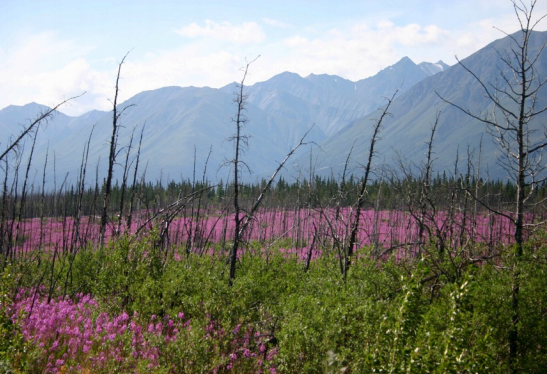Mapping and Modeling Attributes of an Arctic-Boreal Biome Shift

Principal Investigator
Scott Goetz
co-investigators
Logan Berner and Michelle Mack (Northern Arizona University), Brendan Rogers (Woodwell Climate Research Center), Peter Nelson (Laboratory of Ecological Spectroscopy), Matt Macander (ABR Inc. Environmental Research), Adrianna Foster (National Center for Atmospheric Research),
Overview
Warming is happening faster at the poles than anywhere else on Earth. This has implications for vegetation dynamics in the boreal forest and arctic tundra and raises questions about the fate of these ecosystems. We are investigating the ecological gradient from boreal forest to arctic tundra and exploring the extent to which warming will lead to a biome shift whereby tree productivity decreases and mortality increases in the south, and habitat suitability for shrubs and trees increases in the north. We combine satellite and airborne remote sensing, field measurements, and species-specific modeling to investigate evidence for this shift and how it might progress over the next few decades.
In tundra ecosystems we are investigating how and where shrubs and lichen are changing. We use satellite imagery to create shrub and lichen maps, which are then used to monitor changes in shrub and lichen cover and distribution, as well as their relevance to wildlife habitat and forage. In boreal forest ecosystems we are investigating how well we can detect early warning signs of tree mortality using satellite remote sensing, including how tree characteristics detected with remote sensing are related to tree mortality patterns monitored on the ground. This allows us to quantify tree mortality across the landscape, monitor changes through time, identify potential climatic or biological causes of mortality, and ultimately predict where tree mortality is likely to occur over the next few decades.
A third component of the project is investigating how a warming Arctic creates conditions suitable for boreal tree species to expand their range northward. We are using and improving a forest dynamics model specific to boreal tree species and arctic climate and soils. This allows us to not only simulate species-specific patterns of mortality and productivity, based on local climate and site characteristics, but also to predict how these patterns are changing at both the southern and northern margins of the boreal forest.
Funding
NASA Terrestrial Ecology Program

